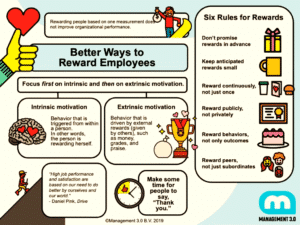
How Extrinsic and Intrinsic Rewards Drive Employee Motivation and Long-Term Performance
How Extrinsic Rewards Improve Employee Contribution and Boost Performance
Motivation theories like Vroom’s expectancy theory state that workers become motivated when they understand that their work efforts will produce desirable benefits (Vroom, 1964). When structured well, an extrinsic reward system can cultivate a performance culture that ensures employees are constantly invested in their roles (Bigabwenkya, 2020). For instance, GreenFriendlyEco introducing performance-based rewards can result in improved performance among teams as employees will be motivated to go the extra mile to earn the rewards. Furthermore, employees feel valued and tend to be more engaged in the workplace when they feel their efforts are seen and appreciated. For instance, being given gift cards and vouchers after lengthy and successful projects can significantly boost morale, encourage employees to go the extra mile, and foster creativity and innovation. Extrinsic rewards also play a pivotal role in organisational performance, particularly when they are aligned with the company’s goals. This alignment enables employees to align their personal objectives with those of the organisation, fostering a shared sense of purpose and commitment. Moreover, the provision of fair and consistent rewards often leads to enhanced employee retention, thereby reducing turnover costs and preserving the wealth of experience and talent within the organisation. For GreenFriendlyEco, offering extrinsic motivators like health and wellness plans, health insurance, career development opportunities, and company-provided retirement plans can help boost employee retention. However, they must note that extrinsic rewards alone will not go very far in enhancing sustainable organisational performance. This is because employees may become only motivated to achieve targets if it is tied to a reward. Furthermore, Maslow’s motivation and Herzberg’s two-factor theories argue that once the employee’s financial-related needs have been met, they crave a higher purpose. Therefore, Extrinsic rewards such as bonuses become irrelevant when overused, as they decrease creativity when employees only aim to meet stated goals for financial gain (Aldabbas et al., 2025). This could lead to a performance nosedive when retracted. Furthermore, it may lead to diminished teamwork, discouraging employees from working together, thus negatively impacting organisational performance. Therefore, while extrinsic rewards can be effective in boosting short-term performance, it’s crucial to adopt a balanced approach that incorporates both extrinsic and intrinsic rewards. For instance, to avoid undermining teamwork, team-based rewards can be introduced to encourage collaboration. GreenFriendlyEco’s management should also ensure that these rewards are distributed fairly and consistently, and that they are complemented by intrinsic rewards, to maintain employee motivation and prevent demotivation.
How Intrinsic Rewards Improve Employee Contribution and Long-Term Performance
Intrinsic rewards are effective in boosting long-term performance, but often work best when used in conjunction with extrinsic rewards. This is because companies cannot always rely solely on extrinsic rewards to elicit an employee’s best work. For instance, GreenFriendlyEco may not always be able to offer bonuses and incentives to its R&D team to drive new product development. However, by enhancing their intrinsic motivation, the team can be consistently motivated to go the extra mile and be creative, leading to the development of new, profitable products that enhance company performance. Intrinsic rewards, such as job satisfaction, professional growth, autonomy, and recognition, are crucial in this process. According to Manzoor et al (2021), employees who value self-improvement and meaningful responsibilities demonstrate increased workplace engagement and extended organisational commitment. This increased engagement empowers employees, enabling them to have purposeful work experiences that promote innovation. Furthermore, they feel respected and continue to drive higher performance (Ibitomi et al., 2022). Sustained organisational performance is possible through intrinsic rewards. These rewards not only motivate workers who share the company’s mission but also help build long-lasting positive employee commitment and high organisational performance over the long term. They engage the employee’s core motivational systems, leading to increased workplace engagement and extended organisational commitment. For example, offering training and development opportunities as part of professional growth or a promotion policy can make employees at GreenFriendlyEco feel appreciated and valued (Thiede et al., 2022). The gained knowledge is applied within the company to benefit from enhanced creativity, innovation, and staying updated on industry trends. It also sharpens its workforce to become resilient and flexible to the coming changes, ensuring the company remains progressive. Furthermore, highly satisfied employees tend to have long tenure, which in turn leads to increased productivity. Nonetheless, while intrinsic rewards significantly impact employee contribution and sustained organisational performance, employees require appropriate financial incentives to maintain their sense of value, thereby preventing diminishing work engagement. Optimal organisational performance depends on how organisations deploy intrinsic and extrinsic reward systems. Each motivator plays a role in employee motivation, but one is not efficient enough without the other. Delivering extrinsic rewards leads to standard performance targets, whereas intrinsic rewards develop expanded worker commitment and creative thinking within the context. Hence, GreenFriendlyEco can seek to preserve employee motivation, decrease turnover and succeed in business by integrating extrinsic rewards through equitable compensation and cultivating intrinsic motivators throughout their culture. The key here is to maintain a balanced reward system that acknowledges the importance of both types of rewards.




